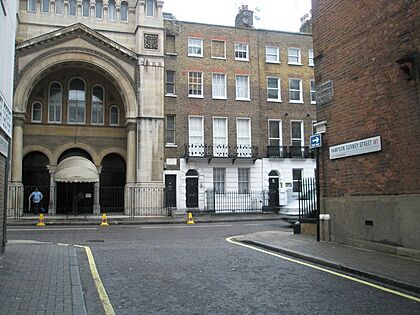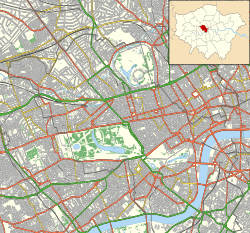West London Synagogue facts for kids
Quick facts for kids West London Synagogue |
|
|---|---|
|
Hebrew: ק"ק שער ציון
|
|

The synagogue, shown from the junction of Hampden Gurney and Upper Berkeley Streets
|
|
| Religion | |
| Affiliation | Reform Judaism |
| Ecclesiastical or organisational status | Synagogue |
| Leadership |
|
| Status | Active |
| Location | |
| Location | 34 Upper Berkeley Street, City of Westminster, London W1H 5AU |
| Country | England, United Kingdom |
| Architecture | |
| Architect(s) |
|
| Architectural type | Synagogue architecture |
| Architectural style | Byzantine Revival |
| Date established | 1840 (as a congregation) |
| Completed |
|
| Construction cost | GB£20,000 |
| Capacity | 1,000 worshippers |
The West London Synagogue, also known as WLS, is a special Jewish place of worship called a synagogue. It is located in Central London, England. Its full name is the West London Synagogue of British Jews. In Hebrew, it is called Kahal Kadosh Sha'ar Tziyon, which means "Holy Congregation Gate of Zion".
This synagogue follows Reform Judaism, a modern way of practicing the Jewish faith. The group that worships here started on April 15, 1840. The building you see today was opened in 1870. It is considered a Grade II listed building, meaning it's important for its history and architecture. It is one of the oldest synagogues in the United Kingdom.
Contents
History of the Synagogue
How the Synagogue Started
On April 15, 1840, 24 families decided to create a new Jewish prayer group. These families, like the Mocattas and Goldsmids, had some disagreements with their old synagogues. They wanted a place where "British Jews" could worship together.
Their new group met in Burton Street and hired Reverend David Woolf Marks in 1841. This new group had a unique approach to their faith. They focused more on the written Jewish laws (the Torah) and less on older traditions. For example, they stopped celebrating the second day of some Jewish festivals. It took almost 100 years for them to fully adopt the ideas of mainstream Reform Judaism.
Moving to New Buildings
On January 27, 1842, the West London Synagogue opened its first permanent building on Burton Street. But soon, it became too small for everyone. So, in 1849, they moved to a new place on Margaret Street. This new building cost about £5,000.
By 1867, they needed an even bigger space. The current synagogue building on Upper Berkeley Street opened on September 22, 1870. This building cost £20,000 and could hold 1,000 people.
When Reverend Marks retired in 1895, Rabbi Morris Joseph took over. He helped the synagogue become more like other Reform Jewish groups.
The 20th and 21st Centuries
Since the 1920s, men and women have been able to sit together during services at the West London Synagogue. In 1929, Rabbi Harold Reinhart joined the synagogue. He helped connect it with the World Union for Progressive Judaism.
In 1942, the West London Synagogue was one of the first members of a group called the Associated British Synagogues. This group is now known as the Movement for Reform Judaism.
In 1957, Rabbi Reinhart left and started a new synagogue called the Westminster Synagogue. Other important rabbis who led the West London Synagogue include Rabbi Werner van der Zyl (1958-1968) and Rabbi Hugo Gryn (1968-1996). Rabbi Julia Neuberger was the Senior Rabbi from 2011 to 2020.
In February 2020, the West London Synagogue paused its membership with the Movement for Reform Judaism. In February 2023, their connection with the Movement for Reform Judaism officially ended.
Synagogue Records
Old records of the synagogue, from 1841 to 1942, are kept at the University of Southampton Libraries.
Leaders of the Synagogue
Here are the main rabbis who have led the West London Synagogue:
| Number | Leader | Start Year | End Year | Years in Office |
|---|---|---|---|---|
| 1 | David Woolf Marks | March 1841 | 1893 | 52 years |
| 2 | Morris Joseph | around 1893 | around 1930 | 36 years |
| 3 | Harold F. Reinhart | around 1929 | 1957 | 28 years |
| 4 | Werner van der Zyl | 1958 | 1968 | 10 years |
| 5 | Hugo Gryn | 1968 | 1996 | 28 years |
| 6 | Mark Winer | 1998 | 2010 | 12 years |
| 7 | Julia Neuberger | 2011 | 2020 | 9 years |
| 8 | Helen Freeman | April 1, 2020 | still serving | 5 years |
| David Mitchell |
Worship and Building Design
How Services are Held
Services at the West London Synagogue use special prayer books from the Movement for Reform Judaism. These books include prayers from different Jewish traditions. A choir and an organ play music during the service.
In this synagogue, men and women sit together. Everyone can also take part in leading the services. Men usually wear a small cap called a kippah, and women can choose to wear one too.
The Synagogue Building
The current building, built in 1870, is close to Marble Arch in London. The main prayer hall was designed in a style called Neo-Byzantine architecture. This style uses elements from old Byzantine buildings, like domes and arches.
The synagogue also has offices, a library, and other rooms for the community. The bimah (the platform where the Torah is read) and the Torah ark (where the Torah scrolls are kept) were built in 1869–70. The synagogue's large organ was built by Harrison & Harrison and was fixed up in 2008. It has 55 different sounds and four keyboards.
See also
- History of the Jews in England
- List of Jewish communities in the United Kingdom
- List of synagogues in the United Kingdom



